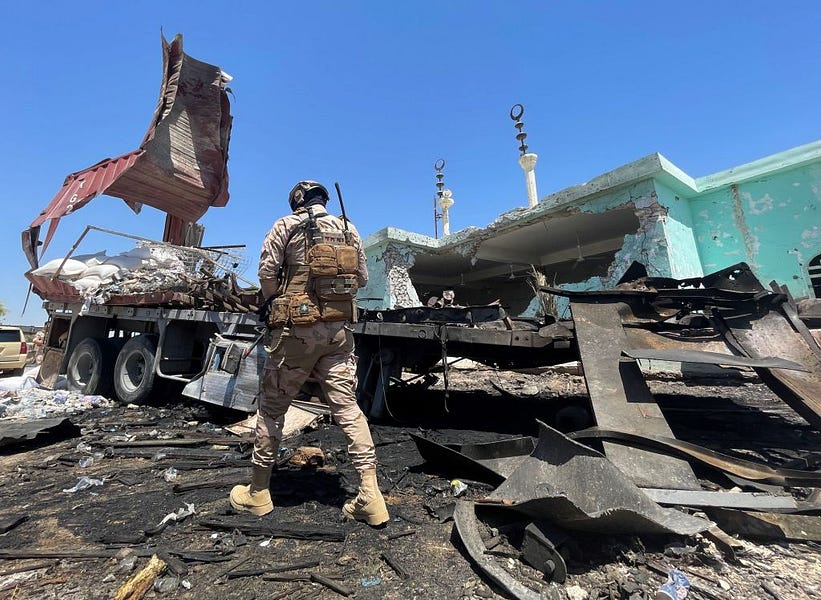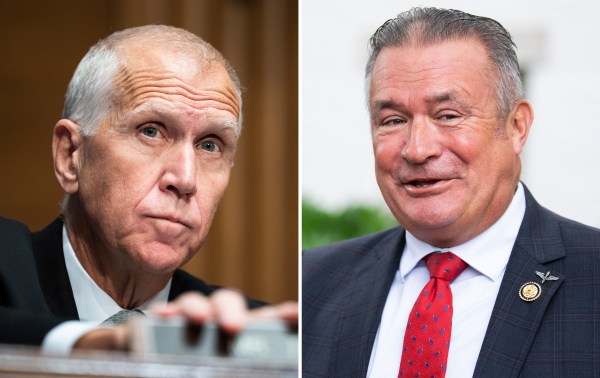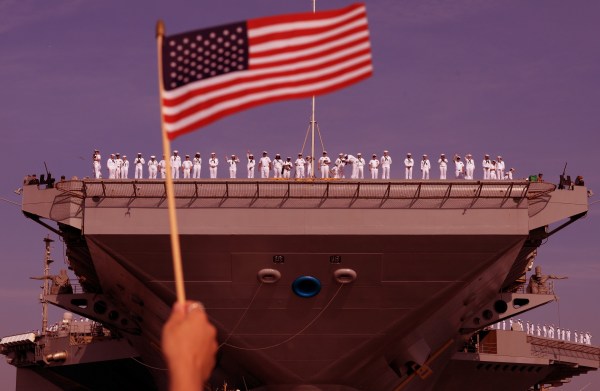During his first week on the job, National Security Adviser Jake Sullivan resumed implementing former Secretary of State Hillary Clinton’s infamous “pivot to Asia,” laying off Middle East analysts in favor of an Indo-Pacific focus. But the region held tight to headlines in the five months that followed, between an 11-day Israel-Hamas conflict, Iranian uranium enrichment amid deteriorating nuclear negotiations, and an ongoing war in Yemen.
President Joe Biden’s latest thorn: Tit-for-tat aerial warfare with Shiite militias in Iraq, where the U.S. military is currently stationed at the request of the sitting government. Last week saw the greatest escalation in rocket and drone fire on U.S. and coalition targets this year, with at least five separate attacks over the course of three days.
On Wednesday, 14 rockets hit western Iraq’s Ain al-Asad Air Base, which hosts the largest concentration of U.S. troops in the country, injuring three. Almost simultaneously, American-backed Kurdish forces in Syria intercepted a drone near al Omar oil field. The U.S. Embassy in Baghdad and a U.S. base on the premises of the Erbil airport were also targeted.
In each, the country’s Iranian-backed militias were quickly identified as the likely culprits. Tuesday, Reuters confirmed rumors that senior Islamic Revolutionary Guard Corp (IRGC) commander Hossein Taeb traveled to Baghdad last week to encourage Shiite groups to ramp up violence against American and allied forces. A senior official in the region reported that Taeb conveyed “the supreme leader’s message to them about keeping up pressure on U.S. forces in Iraq until they leave the region.”
Whether or not this communication constitutes a direct order from Tehran or simply a nonspecific greenlight is unclear, particularly given the multiplicity of Iraqi militias who could be behind the different strikes. “They all want to show that they are making contributions to the resistance, as they call it,” explained Michael Knights, an analyst at the Washington Institute for Near East Policy. “They’re competing with each other, ultimately, as well as collaborating.”
Iran has supported Iraqi insurgent groups to varying degrees since the 1980s, but the fight against the Islamic State (ISIS) in the early 2010s offered Tehran pretense to expand its reach into the country. The war against ISIS also legitimized many of these militias—at least formally—in the eyes of the Iraqi government with the formation of the Popular Mobilization Forces (PMF) to fight in 2014.
“As these militias took positions to fight the Islamic State in the Sunni northwest of the country, they often just dug in and stayed. This was partially part of an Iranian strategy to use their Iraqi allies to supply weapons, ammunition, fighters, and other technology across Iraq, through Syria, to Bashar al-Assad’s government in Damascus, and also to Hezbollah in Lebanon,” Doug Silliman, former U.S. ambassador to Iraq and president of the Arab Gulf States Institute in Washington, told The Dispatch. “So in one sense, a lot of these Shia militias and now parts of the PMF are elements of Iranian strategic power projection into and through Iraq, into Syria and Lebanon.”
The PMF, composed primarily of several Shiite militias, is formally a part of the Iraqi security forces and receives government funding. Many of its member groups also receive financial and tactical support from Iran.
“There are two general types of militias: Those that arose after Grand Ayatollah Ali Sistani’s 2014 call issued in response to the rise of the Islamic State, and those that preceded that event. Iran trained and largely controls financially if not through direct orders the earlier militias,” Michael Rubin, a former Pentagon official and resident scholar at the American Enterprise Institute, explained. “They have little nationalist or religious legitimacy, but often seek to cloak themselves in the mantle of the Sistani-blessed militias who really did fight for Iraq and only for Iraq.”
This allegiance of some militias to two states generates incentive to obscure the provenance of attacks on U.S. and coalition targets, and the establishment of subgroups—like the “Muhandis Brigade” that took credit for the Ain al-Asad rocketfire—allows them to do so.
“The Iranians have their established militia organizations, and then they have breakaway organizations that are meant to insulate the role of those groups, and by extension Iran’s fingerprints on any escalation or aggression against U.S. and coalition forces,” said Jason Brodsky, senior Middle East analyst and editor at Iran International. “This is a tactic Iran has used repeatedly in the past in Iraq and in other theaters to conceal and camouflage its role.”
In a December 2019 brief for the Center for Strategic and International Studies, Missile Defense Project research associate Shaan Shaikh put the number of fighters—making up the 50-plus militias of the PMF— between 75,000 to 145,000. The large range is indicative, Shaikh explained in an interview with The Dispatch, of the opacity surrounding these groups.
Knights and a team of analysts at Washington Institute founded Militia Spotlight, a research blog tracking Iranian-sponsored violence in Iraq and Syria, to cut through some of the confusion. Tracking physical and online evidence, the site connects larger groups—like Kataib Hezbollah and Asaib Ahl al-Haq—to what it calls their “facade” organizations.
“What we can see at those moments when the real world groups disagree is that their associated facade groups also disagree,” Knights explained.
Different weapons systems can also be tracked to draw a line between the fighters carrying out attacks and their material supporters. Often, that line connects back to Tehran.
Drone use among Shiite militias in Iraq, for example, began in earnest in April this year. The KAS-04 fixed-wing drone believed to be operated by Kataib Hezbollah is a variant of the Samad system deployed by Yemen’s Iranian-backed Houthis. Other unmanned aerial vehicle (UAV) systems, like an adaptation of the quadcopter drone, are also suspected to be manufactured in Iran and illegally transferred to militias.
After “reckless” rocket launches by Iranian-backed groups on Erbil in February, Knights explained, Iran began to supply its Iraqi fighters with drone systems to improve their accuracy. “We saw more active, more specific aim points being hit, and those aim points had one thing in common: they were locations where the U.S. had [intelligence, surveillance, and reconnaissance] assets,” Knights said. “So we saw them essentially use a more accurate system not to cause collateral damage, not to kill Americans, but to hit something valuable.”
“You’re seeing the proliferation of lots of drones that can fly low and slow to harass, provoke, or cause connect damage to various things. We used to say that ballistic missiles were the ‘poor man’s Air Force’ back in the 1990s, but what we’re seeing today is that UAVs are the poor man’s cruise missiles—and the line between cruise missiles and UAVs is increasingly blurred,” Tom Karako, director of the Missile Defense Project at the Center for Strategic and International Studies, told The Dispatch. “The small UAS threat is here. It’s not a tomorrow problem. It’s a today problem.”
It was this influx of increasingly sophisticated UAVs that prompted the Biden administration to carry out rare airstrikes in Syria and Iraq border regions on June 27, killing at least seven. But Biden has yet to respond to last week’s drone and rocket strikes, despite a report by the Washington Post this month claiming that the Pentagon plans to react consistently to attacks, regardless of casualties.
If adhered to, this strategy would constitute a break from that of the Trump administration, which established one American death as the red line. “I think the Biden administration is trying to create a fuzzier deterrence,” Silliman said. “They’re not projecting to the Iranians or the militias what their red line is, but rather ‘we reserve the right to respond when we feel it is necessary to do so.’”







Please note that we at The Dispatch hold ourselves, our work, and our commenters to a higher standard than other places on the internet. We welcome comments that foster genuine debate or discussion—including comments critical of us or our work—but responses that include ad hominem attacks on fellow Dispatch members or are intended to stoke fear and anger may be moderated.
With your membership, you only have the ability to comment on The Morning Dispatch articles. Consider upgrading to join the conversation everywhere.